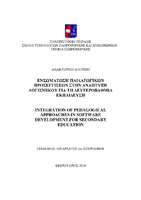Ενσωμάτωση παιδαγωγικών προσεγγίσεων στην ανάπτυξη λογισμικού για τη δευτεροβάθμια εκπαίδευση
Integration of pedagogical approaches in software development for secondary education

Προβολή/
Λέξεις κλειδιά
Εκπαίδευση ; Μαθητοκεντρική μάθηση ; Κόμικς ; Δημιουργία ψηφιακών κόμικς από τους μαθητές ; Δημιουργία πολυτροπικών κειμένων ; Σχολικό μάθημα πληροφορικής ; Γνωστικό φορτίο ; Μέτρηση γνωστικού φορτίου ; NASA-TLX ; Μοντέλο αποδοχής τεχνολογίας (ΤΑΜ)Περίληψη
Η εξέλιξη των τεχνολογιών της πληροφορίας και της επικοινωνίας (ΤΠΕ) δεν έχει αφήσει ανεπηρέαστη την εκπαίδευση. Δεδομένου, ότι οι μαθητές συναντούν παντού αναπαραστάσεις της πληροφορίας σε ποικίλες μορφές, πρέπει να είναι σε θέση να τις κατανοήσουν, να τις αξιολογήσουν και να τις παράγουν. Επομένως, η απόκτηση μιας ομάδας ικανοτήτων για την ερμηνεία και τη σύνθεση των μηνυμάτων, τα οποία περιέχουν αυτές τις μορφές είναι επιτακτική. Οι γνωστικές αυτές λειτουργίες περιλαμβάνουν την κριτική σκέψη, την κατασκευή νοήματος, την εξαγωγή συμπερασμάτων, την επικοινωνία, καθώς και την πρόκληση συναισθημάτων και γενικότερων στάσεων. Οι δεξιότητες αυτές μπορούν να διδαχθούν και είναι σημαντική η προώθησή τους στα σχολεία, με την προηγούμενη εμπειρία των μαθητών να διαδραματίζει τον δικό της κεντρικό ρόλο.
Η έννοια των πολυγραμματισμών φέρνει, λοιπόν, νέες προκλήσεις, κατευθύνει τις προσπάθειες των εκπαιδευτικών και διεγείρει το ενδιαφέρον των μαθητών. Η ενσωμάτωση στη διδακτική πρακτική των ΤΠΕ παρέχει στους εκπαιδευτικούς νέες ευκαιρίες να αυξήσουν την ενασχόληση των μαθητών με τις μαθησιακές δραστηριότητες, να βελτιώσουν την ποιότητα διδασκαλίας τους, να προσφέρουν νέες και περισσότερες ευκαιρίες μάθησης καθώς και να βρουν εναλλακτικές δυνατότητες υλοποίησης σύγχρονων μαθησιακών περιβαλλόντων και, επομένως, την επίτευξη καλύτερων μαθησιακών αποτελεσμάτων.
Ανάμεσα στις διαθέσιμες ΤΠΕ, η δημιουργία ψηφιακών κόμικς είναι ιδιαιτέρως ενδιαφέρουσα. Είναι μια καινοτόμος παιδαγωγική προσέγγιση για την παρακίνηση και τη συμμετοχή των μαθητών στις σχολικές δραστηριότητες. Επωφελείται από την αποτελεσματικότητα της πολυτροπικότητας των κόμικς και προσφέρει στους μαθητές την ευκαιρία να αξιολογήσουν τα επίπεδα γνώσης των μαθησιακών αντικειμένων που καλούνται να αντιμετωπίσουν, κάνοντας τις απαραίτητες προσαρμογές, όπου χρειάζεται. Η παρούσα διατριβή συγκρίνει την αποτελεσματικότητα της δημιουργίας ψηφιακών κόμικς από τους μαθητές στην κατασκευή των γνώσεών τους με την αντίστοιχη της παραδοσιακής προσέγγισης διδασκαλίας (βασισμένη σε διαλέξεις) σε ένα αυθεντικό περιβάλλον σχολικής τάξης. Η αποτελεσματικότητα της δημιουργίας ψηφιακών κόμικς εξετάζεται μαζί με την επίδραση σε αυτήν του παράγοντα του φύλου των μαθητών και του μαθησιακού αντικειμένου. Τα αποτελέσματα της μελέτης συνηγορούν υπέρ της δημιουργίας ψηφιακών κόμικς από τους μαθητές αποκαλύπτοντας μια στατιστικά σημαντική διαφορά μεταξύ των δύο διδακτικών προσεγγίσεων. Η μελέτη, επίσης, αποκαλύπτει, ότι η αποτελεσματικότητα της δημιουργίας ψηφιακών κόμικς από τους μαθητές δεν επηρεάζει διαφορετικά τα αγόρια και τα κορίτσια και επισημαίνει τον ρόλο του μαθησιακού αντικειμένου. Η δημιουργία ψηφιακών κόμικς, συμπεριλαμβανομένης της ενεργητικής επεξεργασίας του εκπαιδευτικού υλικού, μπορεί να βελτιώσει τη μάθηση και για τα δύο φύλα, ενθαρρύνοντας τη χρήση της σε αυθεντικές συνθήκες τάξης.
Η παρούσα διατριβή, επίσης, διερευνά την αποδοχή από τους μαθητές της δημιουργίας ψηφιακών κόμικς στις διαδικασίες μάθησης μέσα στην τάξη και στοχεύει στον εντοπισμό των παραγόντων που την επηρεάζουν. Η δημιουργία ψηφιακών κόμικς συνδυάζει το δημοφιλές και οικείο στους μαθητές μέσο των κόμικς με τους υπολογιστές. Το ερευνητικό μοντέλο που χρησιμοποιείται για να εξηγήσει την προτίμηση των μαθητών για τη δημιουργία ψηφιακών κόμικς βασίζεται στο μοντέλο αποδοχής τεχνολογίας (ΤΑΜ). Η στατιστική ανάλυση των δεδομένων χρησιμοποιεί τη μέθοδο μοντελοποίησης μερικών ελαχίστων τετραγώνων μέσω δομικών εξισώσεων (PLS-SEM) για την ανάλυση των δεδομένων και την εξέταση του ερευνητικού μοντέλου καθώς και των αντίστοιχων υποθέσεων. Τα αποτελέσματα δείχνουν ότι οι μαθητές προτιμούν τη δημιουργία ψηφιακών κόμικς στη σχολική τάξη και επιβεβαιώνουν την αποδοχή του μοντέλου. Επίσης, δείχνουν ότι η προτίμηση των μαθητών για τη δημιουργία ψηφιακών κόμικς επηρεάζεται, άμεσα, από την αντιληπτή ευχαρίστηση, την αντιληπτή χρησιμότητα και την αντιληπτή ευκολία χρήσης που προσφέρει. Μεταξύ αυτών, η αντιληπτή ευχαρίστηση είναι ο ισχυρότερος παράγοντας επιρροής. Η αυτο-αποτελεσματικότητα ως προς τη δημιουργία ψηφιακών κόμικς ήταν ένας σημαντικός έμμεσος παράγοντας της προτίμησης των μαθητών για τη δημιουργία ψηφιακών κόμικς, μέσω της αντιληπτής ευκολίας χρήσης. Είναι σημαντικό αυτοί οι παράγοντες να λαμβάνονται υπόψη στην ενσωμάτωση της δημιουργίας ψηφιακών κόμικς ή παρόμοιων δραστηριοτήτων στη σχολική πραγματικότητα, προκειμένου να προσελκύσουν το ενδιαφέρον και τη συμμετοχή των μαθητών.
Η δημιουργία των ψηφιακών κόμικς είναι ένα πολλά υποσχόμενο εργαλείο για να μπορέσουν οι μαθητές να κατασκευάσουν νέα γνώση. Τα κόμικς έχουν ήδη υιοθετηθεί σε αρκετούς κλάδους, καθώς ο συνδυασμός κειμένου και εικόνων έχει αναγνωριστεί ως ένα ισχυρό εργαλείο μάθησης. Όλες οι εκπαιδευτικές δραστηριότητες και τα εργαλεία, ωστόσο, δεν πρέπει να δημιουργούν υπερφόρτωση του γνωστικού συστήματος των μαθητών, η οποία θα έχει, ως συνέπεια, την παρεμπόδιση της μάθησης. Η παρούσα διατριβή, επιπλέον, διερευνά, μέσω του πολυδιάστατου NASA-TLX, το γνωστικό φορτίο που επιβάλλεται στους μαθητές. Ο έλεγχος αυτός πραγματοποιείται σε συνδυασμό με τον έλεγχο της αποτελεσματικότητας της δημιουργίας ψηφιακών κόμικς, μέσω της σύγκρισης της απόδοσης των μαθητών σε ολιγόλεπτες γραπτές δοκιμασίες πριν και μετά τη δημιουργία των ψηφιακών κόμικς. Τα αποτελέσματα αυτής της σύγκρισης είναι, πάλι, υπέρ της δημιουργίας των ψηφιακών κόμικς. Το γνωστικό φορτίο κυμάνθηκε σε κανονικά επίπεδα, όπως και των περισσότερων διαστάσεών του, κάτι που θεωρείται ως θετική ένδειξη για τη διατήρηση του ενδιαφέροντος των μαθητών στη συγκεκριμένη δραστηριότητα, λαμβάνοντας υπόψη και το θετικό αποτέλεσμα της σύγκρισης της απόδοσης των μαθητών στις γραπτές δοκιμασίες πριν και μετά τη δημιουργία των ψηφιακών κόμικς. Η διαδικασία προσδιορισμού του βάρους της κάθε διάστασης του γνωστικού φορτίου έδειξε ότι η απογοήτευση και η χρονική απαίτηση είναι οι πιο επιβαρυντικές διαστάσεις για τις προσπάθειες των μαθητών.
Τέλος, στην παρούσα διατριβή, παρουσιάζονται χρήσιμα συμπεράσματα για τους εκπαιδευτικούς και προτείνονται μελλοντικές ερευνητικές κατευθύνσεις που δημιουργούνται από τα αποτελέσματα και τη συγκεκριμένη ερευνητική πορεία.


